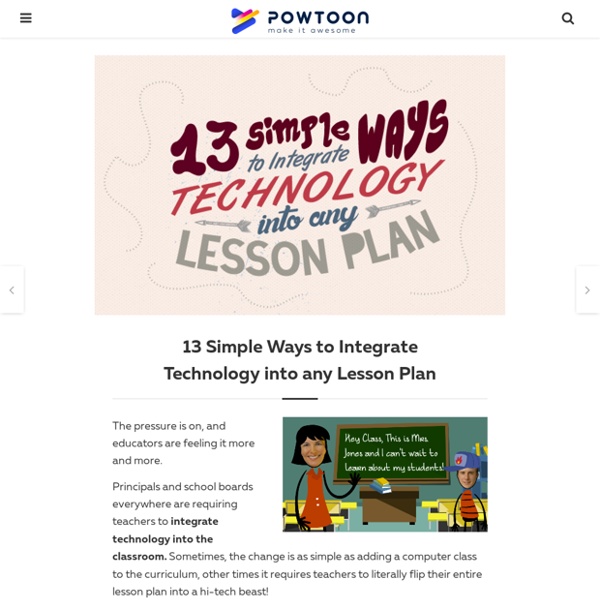13 Simple Ways to Integrate Technology into any Lesson Plan – PowToon Blog

https://www.powtoon.com/blog/13-simple-ways-integrate-technology-lesson-plan/
Related: Educational Technology
What Is Successful Technology Integration?
Technology integration is the use of technology resources -- computers, mobile devices like smartphones and tablets, digital cameras, social media platforms and networks, software applications, the Internet, etc. -- in daily classroom practices, and in the management of a school. Successful technology integration is achieved when the use of technology is: Routine and transparent Accessible and readily available for the task at hand Supporting the curricular goals, and helping the students to effectively reach their goals When technology integration is at its best, a child or a teacher doesn't stop to think that he or she is using a technology tool -- it is second nature.
Tech Lesson of the Week: Technology lesson plans
Education World offers a huge selection of technology lesson plans for all grade levels. Telltale Ts Students use technology to investigate and present information on a variety of animals visited during a trip to the zoo. Engaging English Students use technology to effectively present a selection of alliterative phrases that are then used to create an informative wall or ceiling hanging.
The TPACK Framework Explained (With Classroom Examples)
TPACK is a technology integration framework that identifies three types of knowledge instructors need to combine for successful edtech integration—technological, pedagogical, and content knowledge (a.k.a. TPACK). While TPACK is often compared with the SAMR Model, they are very different in scope. Later, we'll take a look at the differences of these frameworks in more depth.
How to Integrate Technology
Below you will find a quick overview with suggestions of what kinds of tools and activities are best matched with various levels of technology access. All of the resources linked to are either free or offer free versions. If your class has an interactive whiteboard and projector: Try interactive websites such as BrainPOP. Dig in to Scholastic's whiteboard activities page. Show online videos related to the lessons.
8 Engaging Ways to use Technology in the Classroom to Create Lessons That Aren’t Boring
Are you tired of delivering the same old lectures on the same subjects year after year? Are you using the same lesson materials over and over and wishing you could make learning in your classroom more interactive? While lectures and lessons can be informative and even “edutaining” when delivered with passion and good materials by knowledgeable experts, sadly many traditional lectures and lessons are boring, and even worse often ineffective.
4 Uses for Predictive Learning Analytics
Learning & Development (L&D) programs typically have two high-level goals: 1. Successfully imparting knowledge and skills to trainees2. Ensuring that trainees apply their new knowledge and skills on the job While these goals are simple in theory, they are often complex in practice, and it is not always clear which programs or approaches are most effective at achieving them. This ambiguity results in a large amount of scrap learning – training that is delivered, but does not affect job performance, whether due to a failure of learning or development.
How to Integrate Technology into your Classroom - Kognity
For this week’s blog post, we have a guest writer with years of experience in edTech – both teaching himself as well as training teachers on how to incorporate tech into their classrooms. Justin Degonda grabbed his M.Ed. from the University of Minnesota, has seven years in educational technology as an Associate Director of IT and Applications for 42 schools on the east coast of the United States and as an IT Director for a bilingual school in Central America. It does not matter if the classroom is online or in a physical space, studies show student engagement is key to great learning results! Why? Because interaction with learning material engages more than just listening or reading. Good educational technology assists you (the teacher) in designing and delivering an engaging learning environment AND activates student learning potential.
The Teacher's Guides To Technology And Learning
Welcome to the official guide to technology and learning by Edudemic! This part of Edudemic is meant to offer you, the teacher, some of the best and most popular resources available today. We’ve combed through hundreds of resources in order to narrow down our guides into something easy to read, easy to use, and easy to share.
Top 22 Ways To Use Technology in the Classroom
If your state adopted the Common Core State Standards, 75% of you will administer yearly assessments online. If students haven't used online tools or software for classwork, this can be a daunting task. Having computer devices as optional education tools is much different from requiring students to use those devices for graded assessments. This can be intimidating for both students and teachers. The good news: It doesn't take as much time and practice as you might think to prepare for these tests by utilizing technology in the classroom.
Related:



